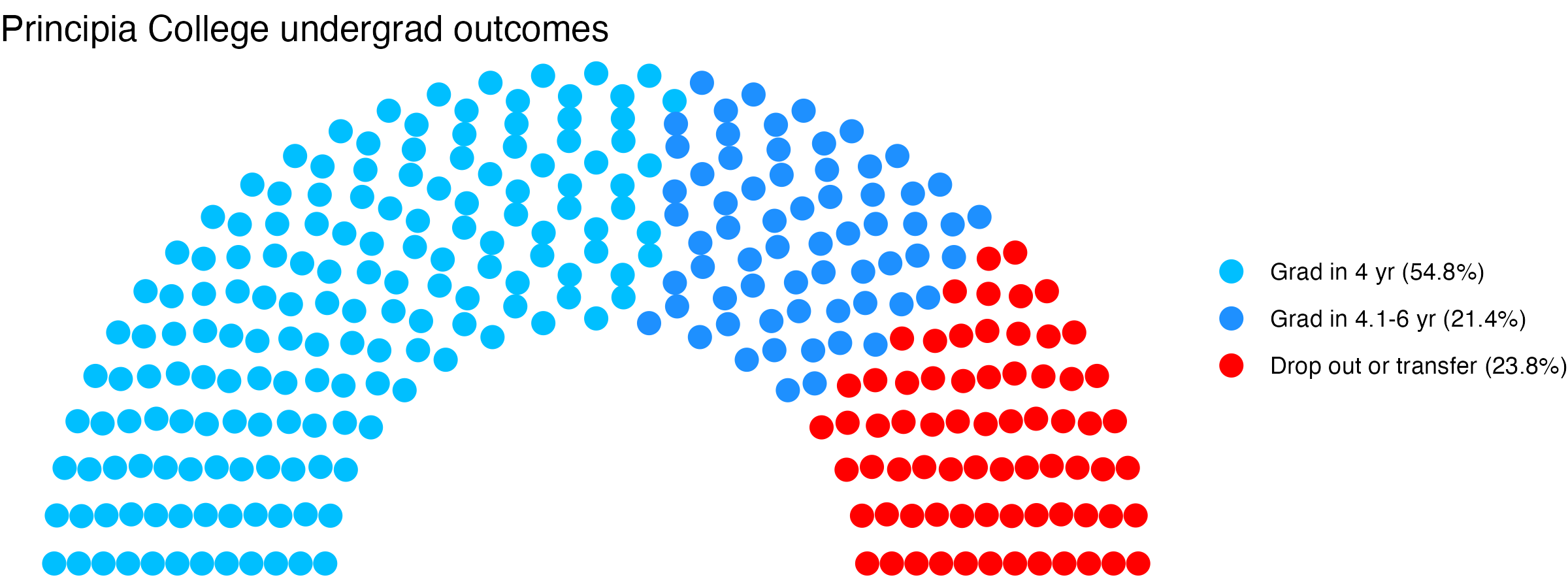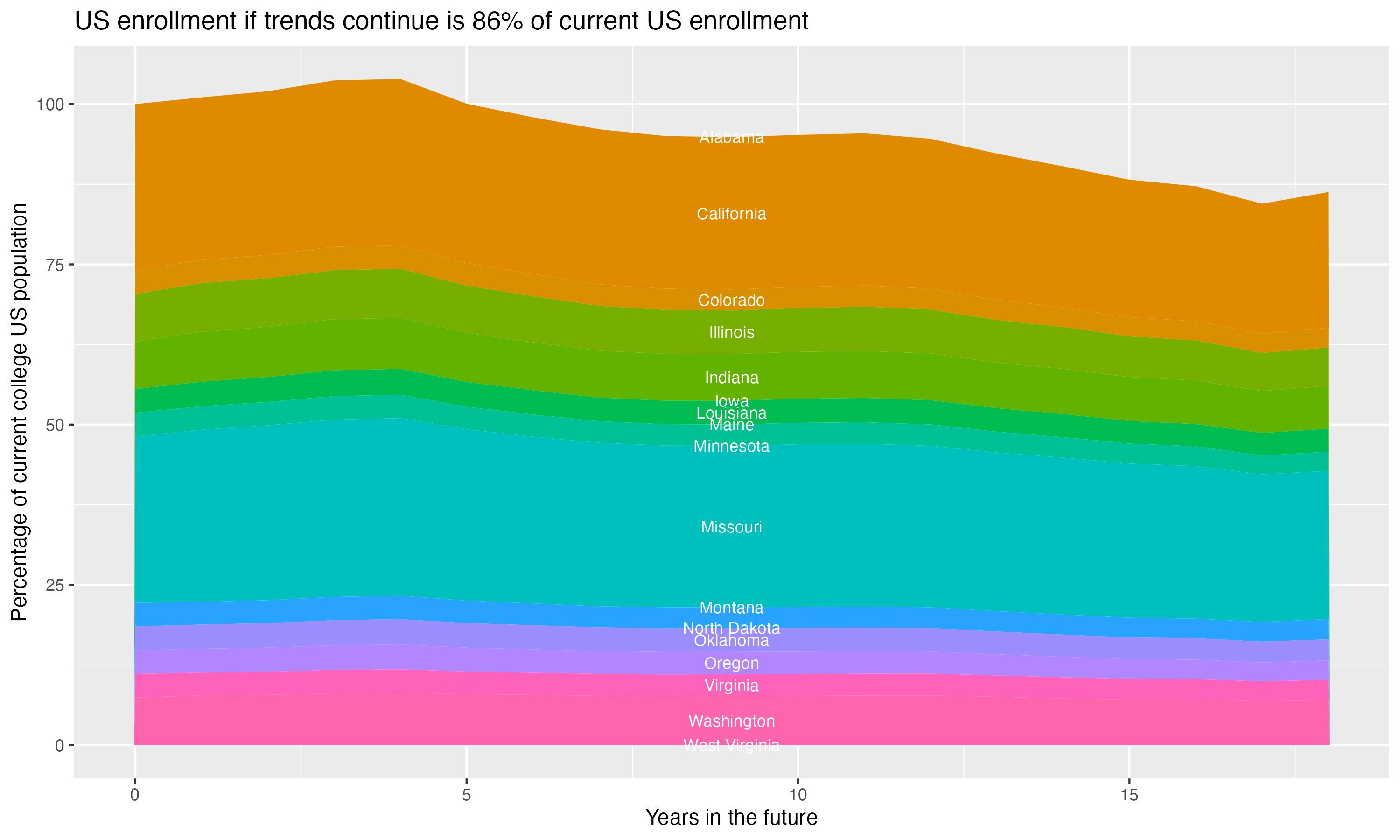Principia College
Principia College is located in Elsah, Illinois. It is a private not-for-profit, 4-year or above institution.
From Wikipedia: Principia College is a private liberal arts college in Elsah, Illinois. It was founded in 1912 by Mary Kimball Morgan with the purpose of “serving the Cause of Christian Science.” Morgan wrote in her book, Education at the Principia that, “Although the College is not affiliated with the Christian Science Church, the practice of Christian Science is the cornerstone of campus life.” Principia no longer requires its students or their parents to be students of Christian Science or Christian Science Church members. Presently, its student body represents 26 countries and a variety of faith backgrounds. Principia sits on bluffs overlooking the Mississippi River between Alton and Grafton in the Metro East region of Southern Illinois, thirty miles north of St. Louis. A portion of the school’s 2,500-acre (1,000 ha) campus is a designated National Historic Landmark District, for its many buildings and design by architect Bernard Maybeck.
.
Overview of institution
This, and the rest of the page, use info from the most recent year available, generally 2024.
Institution kind: Baccalaureate Colleges: Arts & Sciences Focus
Undergrad program: Arts & sciences plus professions, no graduate coexistence
Graduate program: Not classified (Exclusively Undergraduate)
Enrollment profile: Exclusively undergraduate four-year (see more details below)
Average net price for undergrads on financial aid: $14,904 . This is 80% the average cost of Harvard.
Actual price for your family: Go here to see what your family may be asked to pay. It can be MUCH lower than the average price but also higher for some.
Size and setting: Four-year, very small, highly residential
In state percentage: 3.3% of first year students come from Illinois (note that 6.6% have no residence reported)
In US percentage: 44% of first year students come from the US (note that 6.6% have no residence reported)
Graduation rate (within 6 years) for students seeking a Bachelors: 76.2% (this is what is usually reported as “graduation rate”)
Graduation rate (within 4 years) for students seeking a Bachelors: 54.8%
Student to tenure-stream faculty ratio: Unknown (undergrads to tenure-stream faculty) [Tenure explained]
Student to faculty ratio: 5.5 (undergrads to all faculty)
Degrees offered: Bachelor’s degree
Schedule: Semester
Institution provides on campus housing: Yes
Dorm capacity: There are enough dorm beds for 530 students
Freshmen required to live on campus: No
Advanced placement (AP) credits used: Yes
Disabilities: 3 percent or less of undergrads are registered as having disabilities.
Undergrad outcomes
This plot shows the outcomes for first time, full time undergraduates seeking Bachelor’s degrees (if the data are available).

Map
Comparisons
The sections below show this institution compared with others. The ones listed are ones it has identified as peers, who consider themselves peers, and/or who the federal government considers peers. If a comparison school has the same value as the focal school, its cell is grayed out. In fields where there is a common view that higher (or lower) values are better, the best values are in blue, the worst values are in red. If there isn’t a sense of a particular value being better, values are shown in varying shades of green. Arrows show where there is a signficant trend over time for a school. You can swipe across the table to see more of it; the focal school column is always visible.
- Principia College lists these schools as ones to compare itself within federal IPEDS data, and they do the same back: Northland College, Greenville University, Blackburn College
- Principia College compares itself to these institutions, but not vice versa: Barnard College, Williams College, Pomona College, Wellesley College, Davidson College, Amherst College, College of the Holy Cross, Hamilton College, Colgate University, Babson College, Vassar College, Harvey Mudd College, Colorado College, Pitzer College, Denison University, Skidmore College, Macalester College, Mount Holyoke College, College of the Ozarks, Trinity College, Oberlin College, Kenyon College, Methodist College, Occidental College, Connecticut College, Emerson College, Union College, Elon University, Cedarville University, Illinois Wesleyan University, St Lawrence University, DePauw University, Northeastern University Oakland, Hope College, Messiah University, Taylor University, Wheaton College, Calvin University, The College of Wooster, Hobart William Smith Colleges, Carroll University, North Central College, Augustana College, Siena College, Lawrence University, Spring Arbor University, Saint Anselm College, Lake Forest College, Drury University, Butler University, Stonehill College, Wabash College, Webster University, Gordon College, Sarah Lawrence College, Kuyper College, Pacific Union College, Millikin University, St. Joseph’s University-New York, Kalamazoo College, McKendree University, Thomas Aquinas College, Lincoln University, Fresno Pacific University, Le Moyne College, University of St Francis, Viterbo University, Huntington University, Beloit College, Vanguard University of Southern California, Elmhurst University, Manhattan University, Quincy University, Capital University, Andrews University, Alma College, Westmont College, Aquinas College, Rochester University, Kettering University, Saint Norbert College, Assumption University, Judson University, Dominican University, Knox College, North Park University, Columbia College Chicago, Anderson University, Bellin College, Cornell College, Earlham College, Aurora University, Franklin College, Valparaiso University, Keene State College, Emmanuel College, Carthage College, Defiance College, Goucher College, Ohio Christian University, Olivet Nazarene University, The College of Saint Rose, Saint Xavier University, Trinity Christian College, Mount Saint Mary College, Marietta College, Iona University, University of Mount Saint Vincent, Los Angeles Pacific University, Hanover College, Dominican University of California, Illinois College, Hartwick College, St. Francis College, St. Thomas Aquinas College, Rockford University, Heidelberg University, Houghton University, Albion College, Edgewood College, Central Methodist University-College of Liberal Arts and Sciences, Marymount Manhattan College, Bluffton University, Monmouth College, Oakland City University, Ripon College, Wilmington College, Westminster College, Alverno College, Goshen College, Northeastern Illinois University, Lakeland University, Colby-Sawyer College, Ursuline College, Hiram College, Elmira College, National Louis University, Trine University, Fontbonne University, Eastern Nazarene College, Missouri Valley College, Cleary University, Massachusetts College of Liberal Arts, Martin University, Allegheny Wesleyan College, Azusa Pacific University, Manchester University, Albertus Magnus College, Great Lakes Christian College, Keuka College, Culver-Stockton College, The University of Olivet, Wisconsin Lutheran College, Hampshire College, Hannibal-LaGrange University, Hilbert College, East-West University, Concordia University Ann Arbor, Eureka College, Anna Maria College, Wilberforce University, Madonna University, Tiffin University, Curry College, Antioch College, Providence Christian College, Trinity International University-Illinois, Fisher College, Simpson University
- These institutions compare themselves to Principia College, but not vice versa: Martin Luther College, New Saint Andrews College
Enrollment

General
Teaching
Tenure track faculty are those who are eligible for tenure. This includes both pre-tenure and tenured faculty. Once faculty get tenure, they are (generally) protected from being fired for intellectual reasons, helping to ensure their freedom in teaching and research. They can still lose their positions for misconduct, financial problems, not fulfilling their duties, or other reasons.
Non-tenure track faculty are not eligible for tenure. Some are hired one semester at a time, some have multi-year contracts. They typically have a higher teaching load than tenure track faculty, leaving less time for research or other creative endeavors. They are also easier to fire than tenured faculty. Sometimes they are external experts (a noted musician, a former senator) who are hired to teach some classes without the expected permanence of a tenure-track position.
Note that this chart uses US federal demographic data: it only has two genders and a specified set of ethnicities and races.
Having a low student to faculty ratio is considered a good thing by many, as it can mean more individual attention.
Geography
This has information on the location of the institution. See the about page for more information on what the metrics are and how they are calculated.
Financial Aid
Graduation
Note these are bachelors graduation rates in six years, not four (this is standard). Sample sizes can be small for some demographic groups with few individuals in a school, leading to large year-to-year fluctuations and often extreme values for those groups (if there are two individuals in the class with a given identity, the possible graduation rates are 0%, 50%, or 100% depending on whether zero, one, or both students graduate within six years).
Library
Libraries are changing rapidly. Note that how institutions count digital collections may vary.
Diversity
The US Census Bureau has a diversity index that goes from 0 to 1. In their words, “A 0-value indicates that everyone in the population has the same racial and ethnic characteristics. A value close to 1 indicates that everyone in the population has different racial and ethnic characteristics.” This uses their formula, but with the resolution available for the federal IPEDS data (which does not separate for a given demographic group whether members identify as Hispanic or not). This metric is about heterogeneity within the population, not the proportion of the population that comes from historically excluded groups.
Following the practice of the census, the index is multiplied by 100 to give the percentage probability a random pair of individuals will have a different background. Most institutions argue that diversity is a benefit, so by default a higher number is listed as better, but there may be cases where this measure does not reflect the mission of a college (for example, 70% of the students at a tribal college or university may be American Indian: that could be low-scoring by this metric but should not be read as “bad” given the institution’s mission).
These numbers are based on the most recent year available, generally 2024, which predates effects of the US Supreme Court’s striking down of affirmative action. This has often changed, sometimes dramatically, the incoming student demographics at some institutions.
Overall diversity
Freshman profile
Demographic data for first time degree-seeking students. Note that this uses US federal demographic data: it only has two genders and a specified set of ethnicities and races.
Freshman geography
Test scores
SAT scores
ACT scores
Majors
This presents information on the number of majors and the median earnings one and five years after graduation for people who got a degree from this institution in that field. The earnings are for those who are working and not enrolled in further education. The earnings data (from the federal college scorecard) also has information on earnings for those categorized as ‘MALE’ and ‘NOMALE’ – for readability, these are recategorized here as “Men” and “Women”, respectively, which adopts the gender binary used in other federal data. “W/M earnings ratio” is the median earnings of women divided by men, as a percentage.
Bachelors
Masters
Doctorate
Certificate
Associates
Demographic cliff
There is a concern that giving changing US demographics, the number of students in the age groups who most commonly attend four year colleges will drop off, decreasing overall enrollment. This is often referred to as the “demographic cliff”, and it can be a concern for colleges concerned about the risk of falling enrollment. For this section, the analysis uses US census data on the number of people in each state by age, and the proportion of students that come from each state for this particular college, to crudely model what will happen if everything remains constant except the demographic change in the population of 18 year olds in each year – it does not account for things like the college increasing its admission rate, attracting more students from states without the same demographic changes or from other countries, or changes in the proportion of students who go to college.
